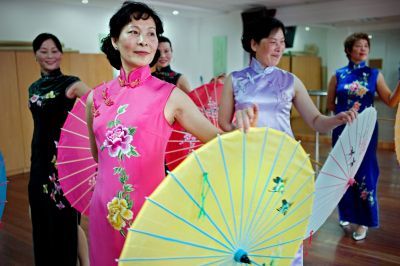Shanghai women revisit 'In the Mood for Love'

Your support helps us to tell the story
From reproductive rights to climate change to Big Tech, The Independent is on the ground when the story is developing. Whether it's investigating the financials of Elon Musk's pro-Trump PAC or producing our latest documentary, 'The A Word', which shines a light on the American women fighting for reproductive rights, we know how important it is to parse out the facts from the messaging.
At such a critical moment in US history, we need reporters on the ground. Your donation allows us to keep sending journalists to speak to both sides of the story.
The Independent is trusted by Americans across the entire political spectrum. And unlike many other quality news outlets, we choose not to lock Americans out of our reporting and analysis with paywalls. We believe quality journalism should be available to everyone, paid for by those who can afford it.
Your support makes all the difference.Wang Weiyu observes her students, all in their 50s, as they gracefully glide around the room to a syrupy soundtrack in their qipaos, the figure-hugging dresses made famous in 1920s Shanghai.
The impeccably coiffed Wang, wearing a bright green frock with hand-stitched fuchsia flowers and dangling earrings, says when she saw actress Maggie Cheung wearing the qipao in the 2000 film "In the Mood for Love", she was inspired.
In 2007, she opened a salon dedicated to preserving the tradition of the qipao, also known as the cheongsam. After her efforts were showcased on television, qipao fans flocked to join her group and others around the city.
"The qipao has 300 years of history," Wang told AFP. "It's one of the most distinctive symbols of Shanghainese culture."
"My mother wore these dresses every day," she added.
The qipao - a long, wide garment that was de rigueur during the Qing Dynasty court - got a new lease on life in the 1920s, when Shanghai's fashion mavens reclaimed it as their own, but with a more alluring body-skimming cut.
Worn by actresses and intellectuals in the "Pearl of the Orient", the dress became a symbol of the modern Chinese woman, the ultimate in femininity and refinement.
Today, 370 Shanghai women aged 22 to 70 - teachers, lawyers, accountants, retirees - come to Wang's salon several times a week to don the slim silk qipao, with its high collar and even higher slit up the side, and dance.
"It's more than a dress - this is about culture and tradition," says the 62-year-old Wang, a former Japanese teacher.
She says her students learn not only how to dance in the dress, but about "etiquette - how to sit, walk, behave and choose the right accessories to go with the dress".
At one session at the dance studio where Wang meets her students, dozens of women - each in a qipao of a different shade - practice a dance to a lilting melody, using brightly coloured parasols, fans and red lanterns as props.
The group has been invited to perform at charity balls and official receptions, travelling as far as Taiwan to show off their skills.
All of the women, most of them older and "well-educated", according to Wang, have stayed rather slim - a necessity to pull off the unforgiving qipao. One says she lost 10 kilos (22 pounds) since she started her qipao training.
"Women in this age group could not wear coloured dresses when they were 20, at the time when they were at their most beautiful," Wang said, referring to the austere rules - and the bleak fashion - of the Cultural Revolution.
"They did not know how to wear these dresses!"
All that has changed now.
"When I wear a qipao, I feel very beautiful. It puts me in a good mood," said 47-year-old Wei Jiali, sporting a vibrant blue dress with golden stitching.
Zhou Fengying, in a pink frock with floral motifs, says she would not have dared to wear a qipao in her youth, but now enjoys sporting one when she goes to the tea house with her old friends.
"You need different coloured dresses for different occasions," said the 53-year-old accountant, who gave a detailed rundown of how to wear the qipao - which can cost up to 5,000 yuan (730 dollars) - and how not to wear it.
"If you're going to a concert, you don't want to be too flashy - you want to be classy, so you'd need a dress in a darker colour, with golden embroidery," she said.
"If you're going to a tea house, wear a rather low-key dress in yellow or grey, perhaps with bamboo patterns," she added.
Zhou's final piece of advice? "If you're going to a wedding, the qipao cannot be too bright or too extravagant - you don't want to upstage the bride! That would be too embarrassing!"
Join our commenting forum
Join thought-provoking conversations, follow other Independent readers and see their replies
Comments